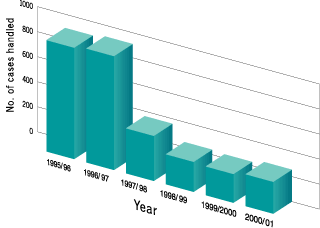|
|
|
|
|
 |
|
Reassessment of TES Rate and Discharge Factor |
|
|
The Sewage Charging Scheme, introduced in April 1995, requires a polluter to pay for the cost of sewage services provided in accordance with the quality and quantity of wastewater discharged. To keep the charge at a modest level, the charges were set to recover only the operating and maintenance costs of the public sewage facilities, while the capital costs of building these facilities will continue to be borne by the Government. |
|
The Charges |
|
|
Customer Enquiries
|
|
|
Reassessment of TES
Rate and Discharge Factor
Among all COD reassessment cases, 12 were withdrawn for either technical or logistic reasons and 54 cases were rejected. In 2000/01, 471 accounts had been successful in demonstrating that the pollution level of their effluent is lower than the generic effluent strength of their respective trades. More than 80% of the applications for COD reassessment had come from restaurant accounts. In addition, 35 consumers had demonstrated that their discharge factors are less than 85% of the values specified in the Regulations for the respective trades. Most discharge factor reassessment cases are related to SC only.
|
||||||||||||||||||||||||||||||||||
|
Business Reclassification 
|
| |
Billing and Consumption
Statistics
|
| |
Revenue and Expenditure
|